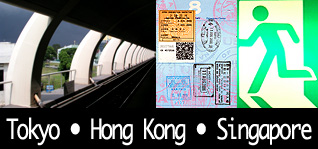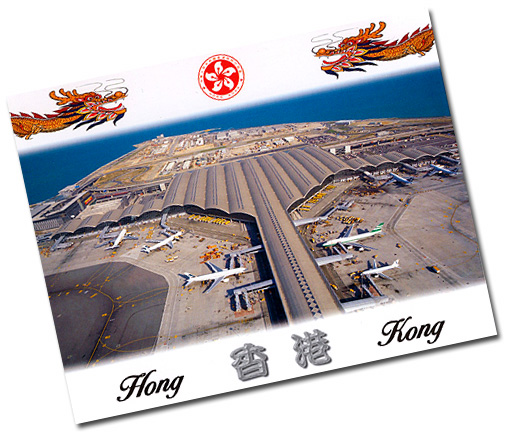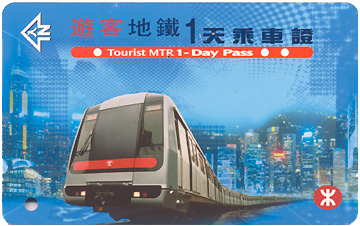
Hong Kong

Hong Kong offers a remarkable
counterpoint to Tokyo. In Japan, I grew accustomed to sharing a light bow of
respect for folks with whom I interacted. Even television anchors begin their
shows with a bow, sometimes at a profound angle, before launching into the news.
I also got used to smiles from strangers who responded to my occasionally clueless
look as I made my way through the city's gargantuan subway and train systems.
Hong Kong, in contrast, is all business. It's not so much that Hong Kong residents
are rude. Rather, they may be more appropriately termed brusque. There's a kind
of manic energy that animates this place.
It is late when I arrive, but Hong Kong's International Airport is bustling
with fast moving passengers and strictly efficient experts in crowd control.
I am engulfed in a crowd of deplaning travelers, submitting to its direction
and presuming that it will take me where I must go. Collectively we flow along
travellators and escalators through customs and toward the departure space.
I spot a hotel check-in desk and find myself selecting a room without much conscious
effort. The attendant shows me the cost, notes the currency exchange, and books
my room. I'm not really in Hong Kong and I'm no longer on the airplane, but
rather somewhere that is not quite physical. Perhaps it's that non-place
discussed by Marc Augé that marks the periphery between the locale and
omnitopia, a site of transfer or waiting that is not quite here and not quite
there. After arranging my room, I am pointed to the airport bus desk. I state
my name and hotel and some uniformed fellow slaps a sticker on my shirt. I hear
something about "orange," and am pointed down an escalator. I have
no idea where I'm going, but I trust the system. Descending, I see orange vests.
I make eye contact with the wearer of one and she points to a seat. Within a
minute, a bus arrives and the driver calls my last name.
Soon we depart the airport and head for the mainland. Onboard, we streak along
a long bridge that connects us to our destination, Tsim Sha Tsui on the Kowloon
Peninsula. To the left, I spot another bridge lined with a red strip that resembles
a laser under the moonlight. Our drive reveals an increasingly impressive array
of buildings each appearing as a clone of its neighbor. It seems that local
urban designers decreed that if one building works pretty well, they ought to
use the construction worker equivalent of copy/paste and erect a dozen just
like it. But Hong Kong harbor is special. With its size, height, and animated
color, this city boasts (arguably) the most impressive skyline in the world.
I’ll know for sure when I can visit Shanghai for a comparison.

No, I don't know what this expression signifies. Believe it or not, of three pictures, this was the best one.
I’m dropped off
at my hotel. Walking the streets past midnight, I am lit by the lights of construction
workers everywhere ripping open the pavement, exposing the ancient sewer system,
and further convulsing the city into whatever it may become in the post-1997
handover era. The city's magnificent skyline is a jewel of glowing buildings
whose animated lights form dazzling images that my camera cannot capture. Yet
in the quarters that have not yet been transformed, where the markets and stalls
sell everything from freshly caught fish to knock-off Rolexes and where feral
cats wander the alleys, the older buildings rot in decay. The 1982 film Blade
Runner set its action in a hellish vision of Los Angeles 2019, but the
inspiration for that film must be Hong Kong.
 The next
day, I investigate the city with the aid of its world-class metro system. While
I’m hardly a jetsetter, I can say with some confidence that the Hong Kong
Mass Transit Railway offers one of the cleanest and most efficient modes of
urban travel you’re likely to try. After purchasing a one-day pass, I
begin exploring this city. In the morning, I amble through Kowloon Park, stopping
to admire the graceful motions of local folks practicing tai chi. I then head
for the Apliu Street Flea Market and the shops of
Hollywood Road where I purchase a copy of Mao’s
Little Red Book, a vinyl record of songs for the "Great Helmsman,"
and a poster of the Chairman leading the people toward a glorious worker’s
paradise. In the afternoon, I catch a movie, Death Note,
a live action version of the popular Japanese manga. Receiving my assigned-seating
ticket, I can’t help but stare occasionally at the huge “no smoking”
sign that glows just to the right of the screen throughout the movie. Later
on, I catch the metro to the Sik Sik Yuen Wong Tai Sin
Temple and then head for Lantau Island in search of the Big Buddha I'd seen
in a travel guide. But I arrive too late for the bus to the statue and settle
for a meal at a nearby restaurant. While I’m eating, I enjoy a leisurely
chat with an expat who moved from California to be near his Hong Kong love.
We compare notes on marriage and the complexities of international travel for
an hour or so and then I depart. Only then does it strike me that we should
at least exchange our names. That night I return to Tsim Sha Tsui to enjoy one
more glimpse of the magnificent skyline. And then I catch the shuttle back to
the airport.
The next
day, I investigate the city with the aid of its world-class metro system. While
I’m hardly a jetsetter, I can say with some confidence that the Hong Kong
Mass Transit Railway offers one of the cleanest and most efficient modes of
urban travel you’re likely to try. After purchasing a one-day pass, I
begin exploring this city. In the morning, I amble through Kowloon Park, stopping
to admire the graceful motions of local folks practicing tai chi. I then head
for the Apliu Street Flea Market and the shops of
Hollywood Road where I purchase a copy of Mao’s
Little Red Book, a vinyl record of songs for the "Great Helmsman,"
and a poster of the Chairman leading the people toward a glorious worker’s
paradise. In the afternoon, I catch a movie, Death Note,
a live action version of the popular Japanese manga. Receiving my assigned-seating
ticket, I can’t help but stare occasionally at the huge “no smoking”
sign that glows just to the right of the screen throughout the movie. Later
on, I catch the metro to the Sik Sik Yuen Wong Tai Sin
Temple and then head for Lantau Island in search of the Big Buddha I'd seen
in a travel guide. But I arrive too late for the bus to the statue and settle
for a meal at a nearby restaurant. While I’m eating, I enjoy a leisurely
chat with an expat who moved from California to be near his Hong Kong love.
We compare notes on marriage and the complexities of international travel for
an hour or so and then I depart. Only then does it strike me that we should
at least exchange our names. That night I return to Tsim Sha Tsui to enjoy one
more glimpse of the magnificent skyline. And then I catch the shuttle back to
the airport.
 It’s
been a few years since I’ve slept in an airport - a couple nights in Washington
D.C.’s Reagan National Airport - and I figure my research would benefit
from the experience. Unfortunately, I am unable to get “airside”
and am stuck in the terminal’s cold and vast enclosure. An advertisement
proclaims the airport’s design: "Uplifting architecture, bathed in
natural light..." After midnight, however, there's nothing natural about
the harsh white light that fills the cavernous terminal. It's like living under
a giant parachute. Most frustratingly, the terminal seating includes dividers
that render it impossible to stretch out for sleep. Some folks who like me are
waiting for a morning flight manage to contort their bodies into some sort of
sleeping position, but I cannot. So I put my belongings in a cart and shuffle
from place to place. Heavy-lidded, I offer a wan smile at fellow airport zombies
who glide past. By two, I decide to search for a wireless hotspot. A couple
of coffee shops offer wireless internet access but I’d rather not worry
about folks lining up for their turn. Ostensibly, there is no free wireless
in the terminal, but a little patience and some hunting reveals a few tiny spots
where I can get passable reception. So I surf and write and wait for Singapore
Airlines to open their desk.
It’s
been a few years since I’ve slept in an airport - a couple nights in Washington
D.C.’s Reagan National Airport - and I figure my research would benefit
from the experience. Unfortunately, I am unable to get “airside”
and am stuck in the terminal’s cold and vast enclosure. An advertisement
proclaims the airport’s design: "Uplifting architecture, bathed in
natural light..." After midnight, however, there's nothing natural about
the harsh white light that fills the cavernous terminal. It's like living under
a giant parachute. Most frustratingly, the terminal seating includes dividers
that render it impossible to stretch out for sleep. Some folks who like me are
waiting for a morning flight manage to contort their bodies into some sort of
sleeping position, but I cannot. So I put my belongings in a cart and shuffle
from place to place. Heavy-lidded, I offer a wan smile at fellow airport zombies
who glide past. By two, I decide to search for a wireless hotspot. A couple
of coffee shops offer wireless internet access but I’d rather not worry
about folks lining up for their turn. Ostensibly, there is no free wireless
in the terminal, but a little patience and some hunting reveals a few tiny spots
where I can get passable reception. So I surf and write and wait for Singapore
Airlines to open their desk.
| Back |